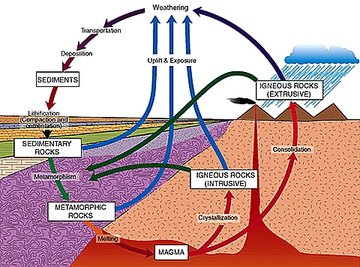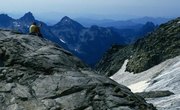
Nothing on Earth looks so solid and permanent as a mass of rock, whether it’s a pebble on a beach or a hulking mountain summit. But on the scale of hundreds of thousands, millions and billions of years, rocks do change: They rise up and wear down, they travel, they decay, they melt. In doing so, they shapeshift into other rocks and provide the raw material for the formation of new ones. These processes compose the rock cycle, the planet's defining geological recycling system.
Introducing Rock Types
Any rock cycle explanation needs to begin with the three major types or families of rocks: igneous, sedimentary and metamorphic. Igneous rock forms when magma – molten rock – cools and solidifies. This rock-forming process may occur underground at depth, in which case the product is an intrusive (or plutonic) igneous rock, such as granite or gabbro. If magma reaches the Earth’s surface and then solidifies, it forms extrusive (or volcanic) igneous rock, such as rhyolite or basalt.
Sedimentary rock may derive from – surprise, surprise – sediment, such as sand or mud, that consolidates and cements (a.k.a. lithifies) into rock when buried and compacted by deposits above. Sandstone and shale are examples. Other sedimentary rocks form when minerals precipitate out of solution, such as when corals secrete calcite to build their sturdy scaffold – creating what’s called biochemical limestone – or when evaporating water leaves behind deposits of rock salt. Dead plant material buried in sediment before it fully decays can produce that noteworthy organic sedimentary rock known as coal.
Intense pressure, heat or both, meanwhile, can transform the mineral structure and/or composition of existing rock, modifying it into metamorphic rock such as slate or gneiss.
The Basic Cycle: The Process of Rock Formation
Fundamental forces set the rock cycle in motion: The internal heat of the planet, for one thing, and the tectonic movements it generates, as well as gravity, solar radiation, and atmospheric moisture, which help establish the processes of weathering and erosion that break rock down.
Because it’s cyclical, there’s not a set starting and end point for the rock cycle. But it’s easiest to think of the cycle beginning with "rock melt": Hot, oozy magma. This solidifies into igneous rock; for example, when a large body of magma rises and cools a bit below the Earth’s surface to generate granite. Weathering and erosion of overlying rock may eventually expose that granite, then acted upon by those same forces, from running water and abrasive wind to freeze/thaw cycles. The breakdown of that igneous rock produces grains of sediment, which may be washed away in rivers and then deposited, say, in a coastal estuary. Sand may then lithify to sandstone, or clay to shale.
If that sedimentary rock is deeply buried, the intense pressure may cause it to recrystallize into metamorphic rock; for example, sandstone into quartzite or shale into slate. A rock later subjected to high temperatures – say, when brought into contact with a mass of magma – can also get hot enough to recrystallize and change to a metamorphic rock.
If, in turn, that metamorphic rock is ever melted, it becomes magma, available to solidify into igneous rock, which puts the rock back to where it started in the rock cycle.
Possible Pathways
Following the rock cycle, it’s easy to see how granite (an igneous rock) can shed the necessary sediment to form sandstone (a sedimentary rock), which if exposed to enough compacting pressure or high heat may evolve into quartzite (a metamorphic rock) – and that, in turn, can melt into magma to become future granite.
But this isn’t the only pathway or rock cycle order, not by any means. An igneous rock can melt to create magma; it can transform into metamorphic rock. The sediments composing sedimentary rock may erode off not only igneous but also metamorphic or existing sedimentary rock, and as mentioned, some sedimentary rocks don't stem directly from the rotted fragments of other rocks but rather from chemical and biological processes. And metamorphic rock can always metamorphose again into a different variety.
References
About the Author
Ethan Shaw is an independent naturalist and freelance outdoors/nature writer based in Oregon. He holds a B.S. in Wildlife Ecology and a graduate certificate in G.I.S. from the University of Wisconsin-Madison. His primary interests from both a fieldwork and writing perspective include landscape ecology, geomorphology, the classification of ecosystems, biogeography, wildlife/habitat relationships, and historical ecology. He’s written for a variety of outlets, including Earth Touch News, RootsRated, Backpacker, Terrain.org, and Atlas Obscura, and is presently working on a field guide.
Photo Credits
public domain/wikicommons.org, CCSABY/Gryffindor/wikicommons.org, public domain/wikicommons.org, public domain/wikicommons.org, public domain/wikicommons.org, public domain/wikicommons.org
